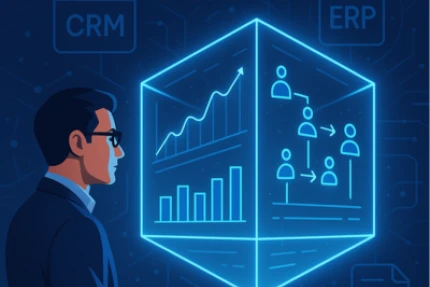
Modern B2B SaaS companies are hyper-focused on performance SaaS metrics and leading indicators. After all, they can be the difference between becoming a unicorn or running out of funding. If you work for a B2B SaaS Company or plan to, it’s possible you’ve heard metrics like CAC Ratio, CAC Payback, Net Dollar Retention, Rule of 40 and Magic Number thrown around. Or maybe you have questioned what is the difference between conversion rates and win rates? In this SaaS Metrics Guide, we cover the most important SaaS KPIs with definitions and best practice calculations.
If you are interested in automating the calculation and trend analytics for these metrics and more, take a look at Discern’s Operational Intelligence solution.
ASP
ASP (Average Selling Price or Average Sales Price) is the average cost of your product or service over a given period.
To calculate ARR ASP, take the sum of your bookings amount over a given period divided by the count of bookings during that period.
Note that ASP calculations will become more actionable when segmented by fields such as opportunity type or product Additionally, ASP calculations will vary by business: some will want to look at ARR for bookings amount while others may want to look at ACV or TCV.
ARR
Annual recurring revenue (ARR) is a financial metric commonly used by businesses to measure the amount of revenue they expect to receive on an annual basis from customers who have signed up for a subscription-based product or service. ARR is an important metric because it provides a predictable measure of revenue for businesses that rely on subscription-based revenue models, making it easier to forecast and plan for future growth.
For companies with monthly billing cycles, ARR is calculated by multiplying the monthly recurring revenue (MRR) by 12. For companies with annual billing cycles, ARR is calculated by taking your starting ARR for a given period, adding new logo ARR, adding expansion/upsell ARR, subtracting churned ARR, and sub-tracking downgraded ARR within that period.
ARR = Starting ARR + New Logo ARR + Expansion ARR – Churn ARR Downgrade ARR
While the ARR calculation seems simple, there are many nuances that can impact this metric. Particularly the way customers engage with your subscriptions. Here is a guide on many ARR accounting scenarios and treatment options.
ARR Growth
ARR growth refers to the percentage increase in a company’s annual recurring revenue (ARR) over a specific period of time. ARR growth is a key metric used to measure a company’s overall business performance and its ability to acquire and retain customers over time.
ARR Growth Rate = (Current ARR – Prior ARR) / Prior ARR * 100%
ARR growth is an important metric for businesses with subscription-based revenue models because it can indicate whether the business is successfully acquiring and retaining customers, and whether it is achieving its revenue goals. High ARR growth rates can also be an indication of future business success, as it suggests that the company is gaining momentum and increasing its market share.
ARR growth can be calculated by comparing the current period’s ARR to the previous period’s ARR, and then expressing the difference as a percentage. For example, if a company’s ARR was $1 million last year and $1.5 million this year, its ARR growth rate would be 50%.
Burn Rate
Burn rate is a financial metric that measures the rate at which a company is spending its available cash or investment funds in order to cover its operating expenses, such as salaries, rent, utilities, and other costs associated with running the business. Burn rate is typically expressed as a monthly or weekly rate, and it is used to measure the speed at which a company is using up its financial resources.
Cash Burn Rate = (Beginning Cash Balance – Ending Cash Balance) / Number of Months
Burn rate is an important metric for startups and other companies that are investing heavily in growth, as it can help them determine how long they can sustain their current level of spending before they need to raise additional funds or generate more revenue. High burn rates can be a warning sign that a company is not able to generate enough revenue to cover its expenses, which can lead to cash flow problems and potentially bankruptcy if the situation is not addressed.
To calculate the cash burn rate, you need to determine how much cash a company is spending each month, net of any cash inflows.
CAC Payback Months
CAC Payback Months (Customer Acquisition Cost Payback Months) is a metric used to measure the length of time it takes for a company to recoup the cost of acquiring a new customer.
CAC Payback Months = (CAC * Sales & Marketing Expense Lagged) / New Logo Bookings * 12
CAC Payback is often a more reliable metric to benchmark against than CAC ratio as CAC ratio is variable and will look different for a company depending on the ASP.
CAC Ratio
CAC ratio (or Customer Acquisition Cost ratio) is a metric used to measure the efficiency of a company’s sales and marketing efforts in acquiring new customers. Discern’s CAC ratio compares bookings totals to the cost of acquiring those bookings over a specific period of time.
CAC Ratio = Sales & Marketing Expense Lagged / Bookings Amount
The CAC ratio can help a company assess the effectiveness of its sales and marketing efforts and make informed decisions about resource allocation. If the CAC ratio is high, it may be an indication that the company needs to adjust its sales and marketing strategies to reduce costs or improve customer retention in order to increase the lifetime value of its customers.
Cash Runway
Cash runway is a financial metric that refers to the amount of time a company can continue operating with its current cash balance, without the need to raise additional funds or generate more revenue. The cash runway represents the amount of time a company has before it runs out of cash and is unable to continue operating.
Cash runway is an important metric for startups and other companies that are investing heavily in growth, as it can help them plan for the future and make strategic decisions about resource allocation. If a company has a short cash runway, it may need to raise additional funds or reduce its expenses in order to continue operating. Conversely, if a company has a long cash runway, it may have more flexibility to invest in growth initiatives or weather unforeseen challenges in the market.
Cash runway is typically calculated by dividing the company’s current cash balance by its monthly cash burn rate, which is the rate at which the company is spending its available cash or investment funds to cover its operating expenses.
Cash Runway = Cash Balance / Cash Burn Rate
FCF Margin
Free Cash Flow Margin (also known as FCF Margin or Operating Cash Flow Margin) is a financial metric that measures a company’s ability to generate free cash flow from its operations as a percentage of its total revenue. Free cash flow is the cash a company generates after accounting for capital expenditures (money spent on investments in property, equipment, or other long-term assets) that are required to maintain or expand its business.
FCF Margin = Free Cash Flow / Total Revenue * 100%
FCF Margin is an important metric as it provides insights into a company’s financial health and ability to fund future growth. A higher FCF margin indicates that a company has a greater ability to generate free cash flow from its operations, which can be used to invest in growth opportunities or return value to shareholders through dividends or share buybacks. A lower FCF margin, on the other hand, may indicate that a company is struggling to generate free cash flow, which could limit its ability to invest in growth or pay dividends.
Gross Dollar Retention
Gross Dollar Retention (GDR) is a metric used to measure the amount of revenue a company retains from its existing customers over a given period, typically a year. It represents the percentage of revenue the company generates from its existing customers compared to the total revenue it generated in the previous year.
Gross Dollar Retention = (Total Revenue from Existing Customers This Year / Total Revenue from Existing Customers Last Year) x 100%
GDR is an important metric for subscription-based businesses or those that rely on recurring revenue from their customers. A high GDR indicates that the company is doing a good job of retaining its customers and generating revenue from them, which can be a key driver of long-term growth and profitability. On the other hand, a low GDR may indicate that the company is struggling to retain its customers or may be facing increased competition in the market.
Gross Logo Retention
Gross Logo Retention (GLR) is a metric used to measure a company’s ability to retain its customers over a given period, typically a year, based on the number of customer logos. A customer logo is a graphical representation or symbol used to identify a customer of a particular company. In other words, GLR measures the percentage of a company’s customers that renew or continue their business with the company in a given period.
Gross Logo Retention = (Number of Customers Renewed / Total Number of Customers at the Beginning of the Period) x 100%
Gross Logo Retention is an important metric for SaaS companies as it provides insights into the company’s ability to retain its customers over time. A high Gross Logo Retention rate indicates that the company has a loyal customer base, which can be a key driver of long-term growth and profitability. On the other hand, a low Gross Logo Retention rate may indicate that the company is struggling to retain its customers, which can lead to churn and revenue loss.
Lead Lifecycle Length
Lead lifecycle length is a metric used to measure the amount of time it takes for a lead to move through the entire marketing and sales funnel, from the initial point of contact to the point of conversion or closure. It represents the average length of time it takes for a lead to progress from being a prospect to becoming a customer.
The lead lifecycle length can vary depending on the complexity of the sales process, the industry, and the type of product or service being sold.
Once you have tracked the time it takes for a lead to move through each stage of the sales funnel, you can calculate the lead lifecycle length by taking the average time across all leads. This can help businesses to identify bottlenecks in the sales process and optimize their sales and marketing efforts to reduce the lead lifecycle length and improve conversion rates.
Magic Number
Magic number is a metric used by software-as-a-service (SaaS) companies to measure the efficiency of their sales and marketing efforts. It represents the ratio of the company’s revenue growth to its sales and marketing expenses.
Magic Number = (New ARR / Sales and Marketing Expense in the Previous Period) x 100%
“New ARR” refers to the additional annual recurring revenue generated in a particular period, while “Sales and Marketing Expense in the Previous Period” refers to the total sales and marketing expenses incurred in the previous period.
A higher magic number indicates that the company is generating more revenue per dollar spent on sales and marketing, which is a sign of efficiency and a positive indicator for growth. A magic number greater than 1 indicates that the company is generating enough revenue to cover its sales and marketing expenses within a year, which is generally considered a good benchmark.
SaaS companies use the magic number to determine the effectiveness of their sales and marketing strategies, and to evaluate the potential return on investment (ROI) of future sales and marketing initiatives.
MRR
MRR stands for Monthly Recurring Revenue. It is a metric used by software-as-a-service (SaaS) and other subscription-based businesses to measure their predictable, recurring revenue streams.
MRR represents the total amount of subscription revenue that a business expects to receive on a monthly basis. It includes the monthly subscription fees paid by customers, but does not include one-time fees or other non-recurring revenue.
MRR = ARR / 12
OR
MRR = Number of Customers x Average Monthly Revenue per Customer
MRR is an important metric for subscription-based businesses because it provides a more stable and predictable measure of revenue compared to one-time sales or project-based revenue. It is also useful for monitoring revenue growth over time and for predicting future revenue streams.
It’s worth noting that MRR can fluctuate from month to month due to factors such as customer churn, upgrades or downgrades of subscriptions, and changes in pricing or promotions. Therefore, it’s important to track MRR over time to identify trends and evaluate the health of your business’s recurring revenue streams.
MQL Creation
MQL creation looks at the number of MQLs (Marketing Qualified Leads) created in a certain period: week, month, quarter or year. Tracking MQL creation is key to ensuring that the top of the sales and marketing funnel is being fed with enough leads to hit pipeline and bookings targets. MQL creation is a leading indicator for pipeline creation.
MQL creation is tracked by counting the number of leads that enter the MQL lead lifecycle stage. It can be tracked with simple reporting in your CRM or marketing automation system.
Net Dollar Retention
Net Dollar Retention (NDR) is a metric used by subscription-based businesses to measure the revenue retention of existing customers over a period of time, typically a year. It represents the change in total recurring revenue from existing customers after accounting for customer churn, upgrades, and downgrades.
NDR = (Ending Recurring Revenue – Lost Revenue + Expansion Revenue) / Beginning Recurring Revenue x 100%
An NDR of greater than 100% indicates that a company is generating more revenue from its existing customers than it is losing from customer churn and downgrades, which is a positive sign for the company’s growth and profitability.
Rule of 40
The Rule of 40 is a popular financial rule of thumb used in the software and technology industry to assess the health of a company’s business model and growth potential. The rule suggests that a company’s combined revenue growth rate and EBITDA margin should be at least 40%.
Rule of 40 = Revenue Growth Rate + EBITDA Margin
For example, if a company has a revenue growth rate of 20% and an EBITDA margin of 30%, then its Rule of 40 score would be 50%, indicating that the company is on a solid financial footing.
The Rule of 40 is used to balance a company’s focus on growth with its profitability. A company that is growing rapidly but not profitable may struggle to sustain its operations over the long term. On the other hand, a company that is highly profitable but not growing may not be able to keep up with the competition and market demand.
While the Rule of 40 is not a hard and fast rule, it is a useful benchmark for investors and analysts to quickly assess the financial health of a company and compare it to industry peers. It should be noted that companies in different stages of growth or with different business models may have different Rule of 40 scores, and a high score does not necessarily guarantee success.
SAL Creation
Like MQL Creation, SAL (Sales Accepted Lead) Creation tracks the number of MQLs that have been accepted by the Sales or XDR team – representing the number of MQLs that are within a company’s ICP.
SAL Creation helps marketing teams understand how many of their leads are of good quality, and it is key to calculating the MQL to SAL conversion rate.
Sales Conversion Rate
Sales Conversion Rate represents the amount of open pipeline closed won vs total open pipeline expected to close during the period.
Sales Conversion Rate = Period Bookings / Total Open Pipeline Expected In Period
Sales conversion rate is an important metric for businesses as it can help them evaluate the effectiveness of their marketing and sales efforts. By tracking their conversion rates over time, businesses can identify which marketing channels and tactics are most effective at converting potential customers into paying customers. They can then use this information to refine their marketing strategies and allocate their resources more effectively to increase sales and revenue.
Note that many companies prioritize win rates over conversion rates for sales performance; however, win rates can be misleading. Sales reps may intentionally or unintentionally keep stale pipeline open, often over-inflating win rate calculations.
Sales Cycle Length
Sales cycle length is the amount of time it takes for a company to close a sale, from the initial contact with a potential customer to the final closing of the deal. The length of the sales cycle can vary depending on factors such as the industry, the complexity of the product or service being sold, and the sales strategy being used.
Generally, a longer sales cycle length can indicate a more complex sales process, which may require more time and resources to close the deal. A shorter sales cycle length, on the other hand, may indicate a simpler sales process and a more efficient sales team.
Measuring and analyzing the sales cycle length can be helpful for businesses to identify areas where they can improve their sales process and increase efficiency. Shortening the sales cycle length can also help companies to close more deals and generate revenue more quickly.
SQL Creation
SQL (Sales Qualified Lead) creation represents the number of SALs that are ready to enter the sales pipeline funnel. SQL Creation is a key metric to help calculate MQL to SQL conversion rate, SAL to SQL conversion rate and SQL to Won conversion rate.
About Discern
B2B companies leverage many of the same technology platforms and want to track the same metrics… so why are business intelligence builds entirely customized? This translates to millions of dollars wasted on additional tooling and headcount and several months or years of platform design.
Discern is eliminating the barriers to achieving cross-functional business intelligence.
By working with leading Private Equity investors, we’ve developed a best practice SaaS metrics BI configuration so you don’t have to start with a blank slate. As a result, clients can get up and running with impactful, valuation-driving insights in a matter of weeks. From there, you can customize the platform to address any nuances.
Did you like this SaaS metrics guide? Check out our SaaS library for more SaaS metrics and KPIs.



